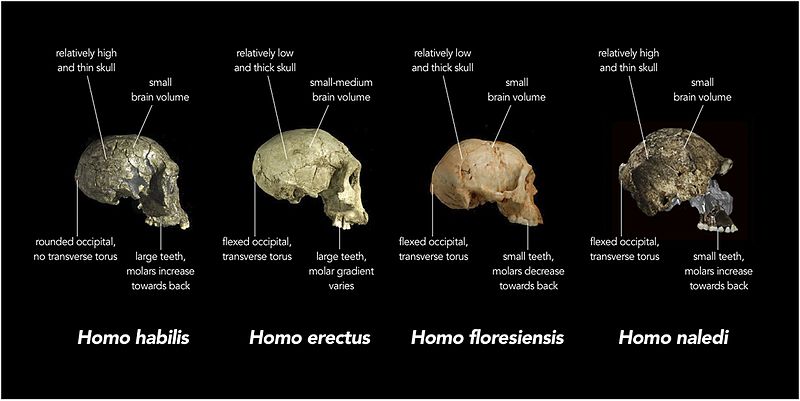| DeskribapenaComparison of skull features of Homo naledi and other early human species.jpg |
Afrikaans: Kraniumreplikas van (van links na regs) Homo habilis (KNM-ER 1813, Koobi Fora, Kenia ∼1.8 miljoen jaar oud), 'n vroeë Homo erectus (D2700, Dmanisi, Georgië ∼1.8 miljoen jaar oud) en Homo floresiensis (Liang Bua 1, Indonesië ∼20,000 jaar oud), word vergelyk met werklike fragmente van kraniummateriaal van Homo naledi wat oor 'n virtuele rekonstruksie afgebeeld word (heel regs; en let daarop dat dié van H. naledi in spieëlbeeld getoon word). Elke kranium is geannoteer met die tipiese kenmerke van die betrokke spesie. Terwyl die harsingmaat van volwasse moderne mense (Homo sapiens) tipies tussen 1000 en 1500 kubieke sentimeters (cc) beslaan, wissel dié van H. habilis van omtrent 510 tot >700 cc, dié van H. erectus van omtrent 550 tot >1100 cc, H. floresiensis is sowat 426 cc, en H. naledi wissel tussen 466 en 560 cc. In moderne mense is die oksipitaalbeen (aan die skedelbasis) ook tipies gelykmatig afgerond in profiel, teenoor dié van sekere vroeë mense soos H. erectus, waar die hoër en laer dele van die oksipitaalbeen by 'n skerp hoek of ‘knak’ ontmoet, met 'n opvallende beenrif wat regoor die beenknak strek (die sg. transversale torus).
English: Replica crania of (left to right) Homo habilis (KNM-ER 1813, Koobi Fora, Kenya ∼1.8 million years old), an early Homo erectus (D2700, Dmanisi, Georgia ∼1.8 million years old) and Homo floresiensis (Liang Bua 1, Indonesia ∼20,000 years old) are compared with actual fragments of cranial material of Homo naledi that have been overlaid on a virtual reconstruction (far right; note some of the images of H. naledi material have been reversed). In each case, the crania are labelled with the typical features of each species. For example, while the adult brain volume of modern humans (Homo sapiens) is typically between 1000 and 1500 cubic centimetres (cc), H. habilis ranged from about 510 to >700 cc, H. erectus from about 550 to >1100 cc, H. floresiensis about 426 cc, and H. naledi between 466 and 560 cc. Furthermore, in modern humans, the occipital bone (at the back of the skull) is typically evenly rounded in profile, whereas in some early humans such as H. erectus, the upper and lower portions of the occipital are sharply angled to each other (i.e., ‘flexed’), and there is a strong ridge of bone running across the angulated region (called a transverse torus). |



